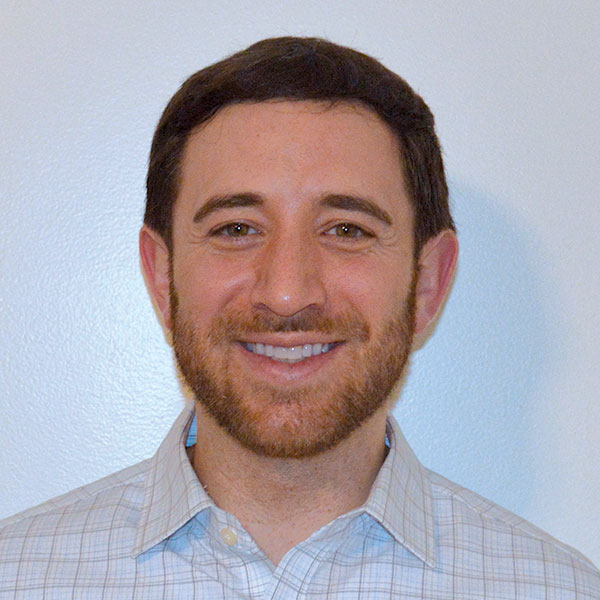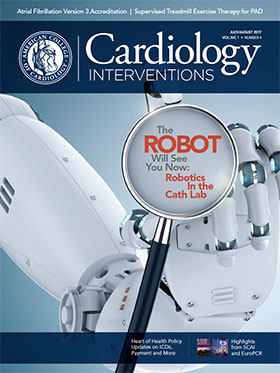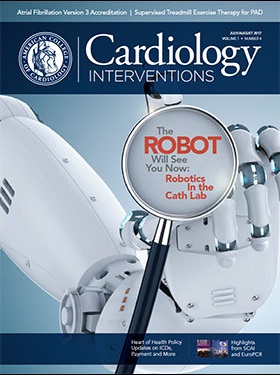FIT Editor: An Interview, An Introduction

Eric Secemsky, MD, MSc, begins his tenure as the editor for the FIT column in Cardiology: Interventions with this issue. Secemsky spoke with Cardiology: Interventions about his career and training and shares some pearls of wisdom for FITs following in his footsteps.
When did you know interventional cardiology was for you?
When I first applied for a cardiology fellowship, I’d planned to pursue electrophysiology because of my research interest in the epidemiology of sudden cardiac death. But after I rotated through the catheterization laboratory, I quickly knew this was my calling. My father is an interventionalist and like him I’ve always enjoyed working with my hands and caring for acutely ill patients.
I appreciate the breadth of procedures now being performed in the catheterization laboratory. Just the other day, I had the opportunity to open a chronic total occlusion of a right coronary artery, close an atrial septal defect and stent a renal artery. It’s also a fantastic feeling to encounter a critically ill patient with a STEMI and have them sitting up in bed, eating and free of chest pain just a few hours after presentation.
Given your experience working with underserved patients in the San Francisco area, what quality improvement initiatives do you think will be most important to improve clinical care in the future?
That is a tough question, especially with the unclear future of the Affordable Care Act (ACA). While I was training in San Francisco, the ACA had not been passed. However, there was “Healthy San Francisco,” a city-wide insurance plan for the underserved and uninsured. Through this program, every resident of San Francisco could receive healthcare, an amazing feat. I’m a strong believer that medical insurance for every U.S. resident is critical to improving our country’s clinical care, both regarding the quality of medical care and as a means to reducing inflating costs tied to healthcare access and preventive services. In addition, the city’s county hospital, San Francisco General, offers city residents resources and top notch care. The hospital has extensive outreach programs, such as walk-in clinics, mobile health care units and home health services, which are key to optimizing screening programs and avoiding unnecessary admissions. Every major city, particularly those with large urban centers, need similar quality institutions to care for the underserved and uninsured.
How has medical practice changed since starting your clinical training? Have you noticed key changes specific to interventional cardiology?
That is a very interesting question for a current fellow, albeit a “career” fellow as I have been called. In my more than eight years of post-graduate training, I’ve already seen a lot of change. A system change that I personally experienced was the restriction on resident training hours, instituted by the Accreditation Council for Graduate Medical Education in 2011. I feel that the effect of limiting resident work hours and thus disrupting continuity in patient care resulted in sub-optimal clinical care and worsened the physician training experience. I’m happy to see that change reversed.
In addition, I think the rapid growth in advanced practitioners, who are now integral to the delivery of healthcare in both the inpatient and outpatient settings, is quite remarkable. These clinicians were not nearly as prevalent when I started residency in 2009.
From a practice standpoint specific to interventional cardiology, I think the biggest evolution has been the development of the percutaneous transcatheter aortic valve replacement (TAVR). When I started residency in 2009, the original PARTNER trial had just been completed and TAVR was only available to those able to be enrolled in a clinical trial. Otherwise, we did not have anything to offer patients with severe aortic stenosis other than medical therapy. Now, we’re performing more than eight TAVRs a week at my hospital, with a rapidly increasing waitlist. With the positive short-term outcomes among patients at intermediate surgical risk, this patient population is only expanding. This is such a game-changer for patients without options.
You have more than 20 publications in peer-reviewed journals, including several in JACC: Cardiovascular Interventions. What helps you determine which questions are worth researching?
I have been incredibly lucky to have amazing research and career mentors. Pursuing research during clinical training can be challenging and is only accomplishable when you have the support and dedication of a mentor. Furthermore, having been given the opportunity to be involved in practice-changing research was critical in my desire to pursue a research career.
Regarding how to determine worthwhile research ideas, some of these develop naturally, such as recognizing a gap in clinical knowledge while seeing patients, or as a continuation from a prior study. For example, I recently published an analysis in JAMA Cardiology assessing the mortality risks of late bleeding and ischemic events after coronary stenting. This question arose organically while we were developing the DAPT Score to assist in determining the length of dual antiplatelet therapy (DAPT) after stenting; we wanted to be certain for calibration purposes that the prognosis following each of these events were near equivocal.
Also, I spend a lot of time brainstorming interesting and unstudied research topics. I keep an extensive list of ideas that I take to Dr. Yeh every few months to “pitch,” similar with the show “Shark Tank,” although much less intimidating. I’d say one in 10 ideas ends up being something we want to pursue, yet I think it is a critical exercise. Research should be fun and creative, and this has helped me produce some of my best ideas.
What’s it like to work and publish with giants like Laura Mauri, MD, FACC, Robert Yeh, MD, FACC, and others?
It’s incredibly humbling to work with my research mentors, Dr. Yeh and Dr. Mauri. They have such amazing reputations, both within our institutions and worldwide. Just looking at their PubMed listings is intimidating. But, I’ve had the privilege to get to know them as the wonderful people they are, along with being career mentors and personal role models. Both have expertly figured out how to balance their busy careers and time for family. Every time I pursue a new project with either of them, I feel that I grow as a researcher. Both push me to produce my finest work, and I have the upmost respect for their dedication to research methodology and integrity.
Who are your mentees? What pearls of wisdom do you find yourself giving them to help navigate their careers?
Throughout my training, I’ve experienced a lot of enjoyment and satisfaction from mentoring those in the training years following me. This usually involves first and second year cardiology fellows or internal medicine residents interested in pursuing cardiology, but I’ve also had great experiences working with medical students from Harvard Medical School.
When I meet with current residents and fellows interested in academic interventional cardiology, I have three main pearls of wisdom. First, spend some time identifying what they are passionate about and envisioning their ideal future career. When training in an academic center, there is always a persistent pressure to pursue research as a career. However, this may not be for everyone. Particularly in interventional cardiology, it’s very challenging to balance both a dedication to clinical practice and to research if one is not truly passionate.
Second, I discuss the importance of choosing a mentor. I think this sometimes goes under-recognized, as many trainees just want to jump on a project, especially with the pressure of the application cycle. However, the pathway to achieving success in academics is not the result of a single publication, but more often the result of a successful relationship between yourself and your mentor. This will in turn provide many research opportunities and often lead to career opportunities.
Lastly, I emphasize the importance of formal statistical training for those interested in health outcomes research. Much of what we do today involves analyzing large databases and registries, which require increasingly complex statistical methods that are hard to pick up without formal training. The perfect time to pursue additional statistical education is around the time of fellowship, either during a general cardiology fellowship that has dedicated research time or just after. By integrating this training with fellowship, it allows for a better understanding of the area one intends to study during her or his career and what skill sets are needed.
What do you wish someone told you at the beginning of your career?
I think if I could choose advice to have received when finishing medical school, it would be to remain patient and enjoy the training process. It has been an incredibly long road to completing training, which has come with both good and bad stretches. However, I’ve had the opportunity to train with world-renowned experts, make lifelong friends and develop my career such that I feel confident I’ll be ready to practice independently. I’d also want to be reminded to stay in the moment. I always have the tendency to be thinking ahead to the next step, whether that’s to the next fellowship or my first job. However, it’s critical to try and remain in the present and enjoy the process, as I’ll never have this opportunity again.
Who has helped you along the way?
By far and away, the most critical contribution to my success as a physician-scientist has been the support from my family. I have a wonderful wife who has been patient, understanding and supportive, which says a lot as my training has taken five years longer than her own (she’s a dermatologist). I couldn’t imagine going through this process without someone like her. I have a 2-year-old daughter, who is the other love of my life and motivates me to be a better person every day. As a clinician, my father has been an amazing source of motivation. I’ve always admired his dedication to his patients and his ability to work with and lead his colleagues. My mother, who passed away from lymphoma during my general cardiology fellowship, is a continuous spiritual presence and guidance for me. I was incredibly close with her and having had the experience of caring for her during her acute illness gave me a new perspective on what it is like to suffer with someone through an illness. This experience constantly motivates me to remain thoughtful of and dedicated to my patients and their families.
Eric Secemsky, MD, MSc is a coronary and vascular interventional fellow at Massachusetts General Hospital in Boston, MA. He is also a fellow at Harvard Medical School, conducting cardiovascular outcomes research. With more than 20 publications in peer-reviewed journals, Secemsky has had the opportunity to present his findings at multiple major conferences across the country. He received his medical degree from Northwestern University and a Master’s of Science in Epidemiology from the Harvard School of Public Health. Secemsky completed his internal medicine training at the University of California, San Francisco, and general cardiology training at Massachusetts General Hospital. After completing his fellowship, Secemsky plans to pursue a career in academic interventional cardiology with a focus on comparative effectiveness and outcomes research.
Tweet this article: Tweet
 |
|
| Click the cover image above to read the latest issue of Cardiology Interventions in e-pub format or click here to read it on the web! | |
Keywords: ACC Publications, Cardiology Interventions, Fellowships and Scholarships, Education, Medical, Graduate, Mentors, Transcatheter Aortic Valve Replacement, Patient Protection and Affordable Care Act, Medically Uninsured, Research Personnel, Renal Artery, Vulnerable Populations, Quality Improvement, Inpatients, Research Design, Coronary Vessels, Calibration, Critical Illness, Myocardial Infarction, Hospitals, County, Accreditation, Internship and Residency, Patient Care, Patient Care Team, Heart Septal Defects, Atrial, Aortic Valve Stenosis, Chest Pain, Catheterization, Death, Sudden, Cardiac, Stents, Prognosis, Electrophysiology
< Back to Listings

